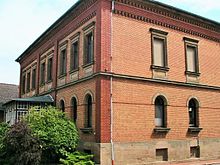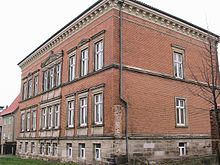Rübenburg
Rübenburg (also Rübenpalast ) is a popular expression for the new villa-like building of a farmhouse. This refers to houses that were built in areas whose farmers achieved some prosperity through the cultivation of sugar beet . The name has spread mainly in the regions of Braunschweig and Magdeburg .
history
At the end of the 19th century, sugar beet cultivation became established in regions with suitable soils. The plant needs deep, nutrient-rich loess soils , which are mainly found in the bordering landscapes . One of the largest contiguous bordering regions extends from the Braunschweig / Hildesheim area to Magdeburg . After successful breeding of sugar beet from beetroot and with the development of new fertilizers, the ground was prepared for the development of the sugar industry in the Aeolian regions.
After the peasants' liberation , which was completed around 1850, the peasants were offered new ways of doing business. When they started growing sugar beet, the sugar factories necessary for production were built at the same time . The beet farmers were involved as shareholders in the factories, which were mostly built not too far away (the plants were usually called "Actien sugar factory"). So you earned money not only from growing sugar beet, but also from selling the sugar and other end products.
In this way, a number of beet farmers achieved considerable prosperity and expressed this by building their new home. Where previously the rural half-timbered house stood, stone palaces now shot up from the ground. In many cases, one orientated oneself on the bourgeois villas that were built in the cities at the same time. Recurring elements were magnificent staircases, large entrance halls and stairwells, window frames with cement stucco , ornaments , columns , gables , balconies , outdoor seating . The builders preferred architectural forms of the Renaissance and Historicism . In this way, the farmers tried to reach the status of aristocratic landowners, whose mansions were often only a few meters away.
The fact that the peasants displayed their new wealth in this way was not without reaction from the village population. Envy and ridicule about the new ostentatiousness quickly gave rise to the term “turnip castles”, which has been popular with people to this day. In the meantime, however, many current owners are also complaining about the high costs involved in maintaining the buildings.
In addition, the massive brick churches that were built in parallel in these areas acquired the colloquial and derogatory title "Rübendom".
See also
Web links
- Article about turnip castles in the Peine area
- Article about turnip castles in the Uelzen area
- Newspaper report about the turning cell in the Peine district
- Braunschweig / Ostfalen as a region of turnip castles


